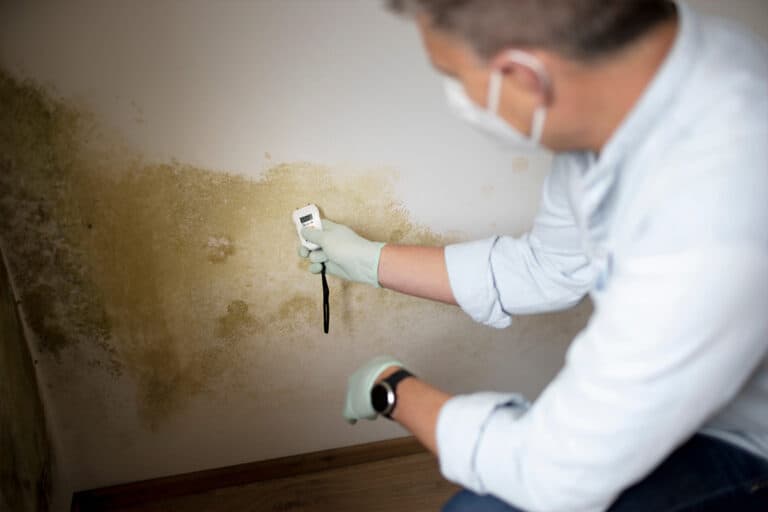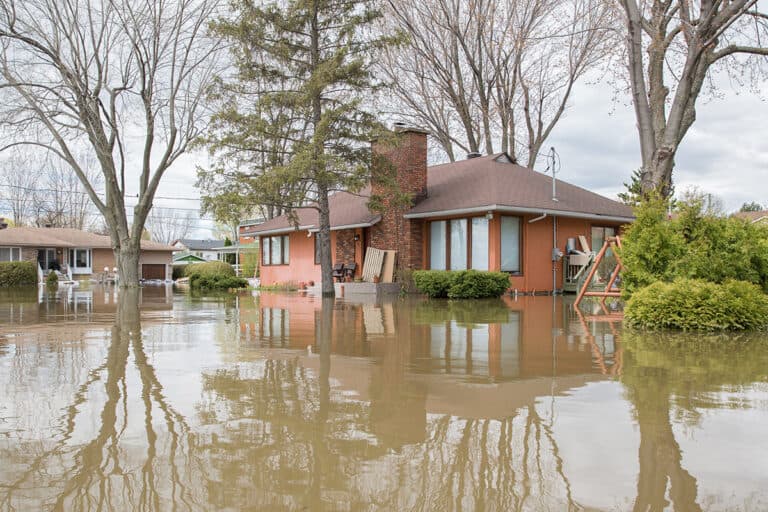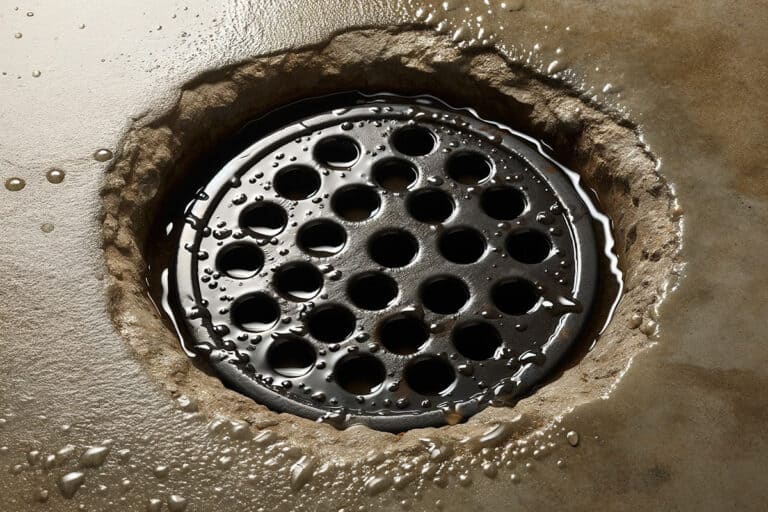Disclosure: I am compensated for purchases made through some links on this site. Click for details.
If you’ve noticed pools of dirty water, odd smells, or water-logged items coming from your basement, you may be dealing with a sewage backup. Raw sewage flooding into living spaces can do major damage and create serious health hazards if not addressed quickly.
In this article, we’ll cover the common causes of basement sewage backups, the risks involved, steps to help prevent backups, and how to safely clean up sewage in basements. Acting promptly and properly at the first signs of a backup can help reduce any resulting mess, repairs or sickness.
If you are going through this, my heart goes out to you. As a former home insurance adjuster, these claims were the most disgusting I’ve ever dealt with. Raw sewage in your home is flat-out disgusting. Even after cleanup, it is hard to separate from the feelings of dirtiness and urges to decontaminate.
Causes of Sewage Backup in Basements
Often out of sight and out of mind, the sewer lines running beneath our homes play a crucial role in maintaining hygiene and comfort. However, when these lines are compromised, the consequences can be dire, particularly in the form of a sewer backup in the basement.
There are a few common culprits behind basement sewage backups:
- Blocked Pipes: Over time, grease, tree roots, debris, and mineral deposits can build up inside pipes leading to clogs. Flushed wipes and paper towels that don’t break down can also get stuck and restrict flow. Sewer line blockages are a main reason sewage backs up into basements through floor drains or pipes.
- Tree Root Invasion: Roots seeking water sources can make their way into cracks or joints in exterior sewer lines. As roots spread they become tangled masses that obstruct waste flow.
- Broken/Collapsed Pipes: If the sewer pipes connected to your home break down or cave in it leads to serious flow problems. Age, ground shifting, excess water pressure, and corrosive materials can all cause pipes to fail.
- Sewer Main Issues: You may have well-maintained interior plumbing, but face backups when municipal sewer lines get blocked or overwhelmed. Heavy rain or snowmelt sends extra stormwater into sewers, exceeding their capacities.
In older cities, many sewer systems combine waste pipes from homes and storm drains from streets. Sudden high stormwater volumes push sewage backward through connections to buildings.
Understanding these causes is the first step in addressing the overarching problem of basement drain backups and how to fix sewer backup in the basement.
Table 1: Causes of Basement Sewage Backups
| Cause | Overview |
|---|---|
| Blocked Pipes | Buildup of grease, wipes, roots and other debris clog pipes, restricting flow |
| Tree Root Invasion | Roots grow into exterior sewer line joints and cracks, tangling into masses that block waste flow |
| Broken/Collapsed Pipes | Age, ground shifting, water pressure and corrosion break down pipes, leading to major flow issues |
| Sewer Main Issues | Excess stormwater or blockages in municipal sewer lines cause backups that spread into buildings |
Risks of Sewage Backup in Basements
The water and waste that accompany a sewage backup can cause substantial damage to your home’s structure and your personal belongings, not to mention the potential long-term issues like mold growth.
Beyond causing expensive home damage, sewage backups create health issues:
- Harmful Bacteria: Raw sewage contains E. coli, shigella, hepatitis A virus, norovirus, and other pathogens that cause serious digestive illness. Kids, the elderly, and those with weakened immune systems are most at risk.
- Tetanus Risks: The bacterium that causes this dangerous nerve disease lives in soil and manure…and thrives in flooded areas filled with extra nutrients like sewage overflow. Anyone with cuts or wounds exposed to floodwaters may develop tetanus.
- Toxic Gases: Stagnant water and sewage breed dangerous methane and hydrogen sulfide gases that displace breathable oxygen. Entering a sewage-flooded space can quickly cause asphyxiation or lethal gas poisoning.
The adverse health effects above are scary enough, but uncontrolled sewage flooding also does costly damage to basements and anything stored in them. Acting quickly to stop backups limits how far waste spreads. Calling water mitigation specialists right after discovering sewage backup helps secure your home and possessions against permanent damage.
Table 2: Sewage Exposure Risks & Precautions
| Risk | Possible Health Effects | Precautions |
|---|---|---|
| Bacteria Exposure | Digestive illness, infections | Wear personal protective equipment (PPE) |
| Tetanus Exposure | Nerve damage, breathing issues | Keep vaccinations current |
| Toxic Gas Inhalation | Asphyxiation, organ damage | Ensure proper ventilation and gas detection |
6 Tips to Avoid Basement Sewage Backups
While some factors behind sewage backups are out of homeowners’ control, many proactive measures help mitigate risks:
- Install a Backwater Valve: Backwater valves act as sewer line floodgates, closing off reverse flow during blockages so sewage and stormwater can’t recede back into buildings. Choose durable valves certified by the International Association of Plumbing and Mechanical Officials. Expect costs of $500 to $2,500 depending on pipe sizes and installation challenges.
- Think Twice Before Pouring Grease Down Drains: Oil and grease harden as they cool, sticking to pipe interiors. Over time, thick buildups clog plumbing and sewer connections. Collect bacon drippings, meat fats, and oily leftovers in sealed containers and throw them out with regular trash instead of washing down drains.
- Use a Filtered Drain Cover: A removable screened drain cover collects hair, food scraps and other goop dangling mid-pipe so it doesn’t create clogs further downstream. Just lift out the filter tray and debris occasionally for easy clearing.
- Have Roots Removed: If invasive roots already grip your external sewer line, have them removed with hydro jetting or mechanical rodding before they mushroom. As routine maintenance, inspect the exterior drainage layout every couple of years for new root growth. Destroy new extensions immediately before they turn into more widespread blockages.
- Fix Drips and Leaks: Small leaks might not seem a big deal, but over time constant dripping introduces extra water to your plumbing and places an additional burden on municipal sewer capacities. Repair any leaks promptly, and confirm toilets, faucets, and pipes are still watertight after basement flooding recedes.
- Keep the Drains Clear: Avoid treating toilets or sinks like mini landfills. If poured fats don’t clog your household plumbing directly, they’ll still contribute to eventual blockages downstream. Follow “flushable” wipe labels carefully, as many shouldn’t enter sewers despite marketing claims. They cling together inside pipes.
What To Do When Sewage Backs Up in Your Basement
If you’re faced with a sewage backup in your basement, immediate and thorough action is required to minimize health risks and property damage. Here’s a step-by-step guide on how to clean, sanitize, and disinfect sewer backup in your basement:
1. Ensure Safety First
Evacuate basement areas disturbed by sewage immediately. If gases are released from drainage areas, toxic fumes displace breathable air extremely quickly. Don’t enter any flooded space with a foul stench.
Call emergency responders if you suspect basement gases endanger occupants. Shut basement doors and vents after exiting to isolate the hazard if possible. Have medical help for anyone reporting nausea or breathing difficulty after exposure.
2. Personal Safety
Before starting the cleanup process, equip yourself with personal protective equipment (PPE) like waterproof boots, protective overalls, gloves, goggles, and N95-rated face masks.
3. Control Access
Tightly shut basement entry doors and seal off vents between flooded areas and unaffected zones. This isolates contamination until professional mitigation assistance arrives.
4. Ventilate Spaces
Once occupied sections are fully evacuated, open exterior windows and position fans to maximize fresh air circulation. This prevents lung-scarring methane and hydrogen sulfide gases from accumulating in stagnant flooded rooms.
Don’t enter contaminated rooms without breathing filters, even once fumes dissipate. Lingering bacteria stay hazardous long after smells cease.
5. Turn Off Power
If water contact with electrical panels or appliance outlets seems likely, carefully toggle the main utility switches off at the first sign of rising water. Avoid electrocution hazards and equipment shortages.
6. Document Damage
Photograph all observed flooding and water-inundated structures like walls, floor joists, and furniture for insurance records before restoration crews arrive. soaked flooring, walls, appliances, Storage containers, and furniture affected by sewage flooding should also be documented.
Log dates/times of first noticing odors or wet areas, when evacuation occurred, and which rooms or items show damage. Photograph all observed sewage contact. Your insurance provider needs written and visual damage verification to process claims.
7. Remove Valuables First
Even with pending full professional cleanouts, immediately move up any undamaged valuables, heirlooms, electronics, and paperwork from flooded rooms yourself to limit contamination.
Separate salvageable and non-salvageable goods and inventory for specialty restoration attempts after professional cleaning.
Quick reaction also reduces possible water damage and mold risks to precious items.
Just be sure to wear personal protective equipment (PPE) when grabbing unsoiled possessions.
8. Call Restoration Professionals
Contact qualified water extraction specialists equipped to pump flooding safely from large indoor areas. Raw sewage requires biohazard precautions, protective gear, and industrial scrubbing solutions most homeowners can’t implement alone.
Don’t attempt to contain major spills by yourself or power-wash floors before seeking expert mitigation assistance. Professionals have testing tools, drying equipment, protective gear, and disinfecting products for proper sewage cleanup.
9. Locate Floor Drains and Pipes
Help mitigation technicians find all basement floor and sewer line access points during walkthroughs.
Locating drainage entry spots helps crews determine flood origins and strategize cleanup plans based on how far waste spreads. Point out whether backups emerge from one central drain or several so they can prioritize response areas logically. Note past locations of clogged fixtures.
10. Address Structural Issues
Before allowing basement re-occupation, inspect compromised load-bearing walls or shifted home foundations requiring structural reinforcement and repair issues creating repeat sewage entry risks.
11. Restore Recoverable Household Items
After technicians fully sanitize the scene, attempt salvaging non-porous possessions like wiped down wood, plastic containers, and electronics using household disinfecting cleaners if undegraded. Porous textiles likely require disposal.
12. Save All Receipts
Hold onto invoices for personal protective equipment (PPE), professional pumping services, container replacements, demolition activities, sanitizing supplies, and all other related costs. Itemized repair bills support potential insurance claims or tax credits for unforeseen flooding impacts and losses.
Table 3: Sewage Cleanup Steps
| Step | Action Item | Description |
|---|---|---|
| 1 | Ensure Safety First | Evacuate all people and pets from affected areas of basement immediately |
| 2 | Personal Protection | Seal off basement entry doors, and vents to isolate contamination |
| 3 | Control Access | Seal off basement doors and vents to isolate contamination |
| 4 | Ventilate Spaces | Open basement windows and set up fans to vent potential gases |
| 5 | Turn Off Power | Shut off electrical systems if water contact seems likely |
| 6 | Document Damage | Photograph flooding and contaminated items for insurance |
| 7 | Remove Valuables | Carefully extract heirlooms and key items from flood zone |
| 8 | Call Restoration Company | Enlist sewage cleanup specialists for containment and sanitization |
| 9 | Locate Drains/Pipes | Show technicians all drains, line access points, and prior leaks |
| 10 | Address Structural Issues | Have professionals ensure your home’s structural stability |
| 11 | Clean Personal Items | Attempt cleaning unsoiled non-porous items after sanitization has finished |
| 12 | Save Receipts | Retain all invoices for repairs and equipment for records |
Knowing When to Call the Experts
While some sewer backups may seem manageable to handle on your own, there are certain scenarios where contacting professional mitigation services is indispensable:
Extensive Damage
If sewage flooding is widespread across multiple basement rooms or the water level is very high, the job likely exceeds typical homeowner response capacities. Water extraction companies have heavy-duty pumps, drying equipment, protective gear, and the know-how to properly clear large volumes of contaminated water.
Recurring Sewage Backups
If your property experiences repeated sewer system backups despite drain treatments or pipe clearing, that indicates a deeper infrastructure issue at play. Contact licensed plumbers specializing in sewer line inspections to diagnose the root cause, such as pipe damage or excessive root intrusions.
Health and Safety Concerns
If you have young children, elderly residents or immuno-compromised people in the home who could develop severe illness through sewage exposure, immediately call mitigation crews rather than taking personal risks testing drainage fixes. Professionals also follow OSHA protocols.
Sewage backups always warrant a swift response. But understanding when to call the experts for assistance can save homeowners time, money, and health – especially when flooding is extensive, recurring or threatens at-risk residents. Stay informed on response limitations.
Sewage Cleanup Tips for After Restoration Finishes
Once mitigation techs complete major containment, sanitization, and structural repairs, follow these last recommendations to ensure home health after sewage flooding:
- Run dehumidifiers for 72+ hours after professionals dry all rooms. Lingering dampness lets mold take hold again quickly in wall cavities and corners. Don’t restore furnishings or store new items until moisture gauges verify dryness.
- Discard porous goods like mattresses, stuffed toys, cardboard boxes, and upholstered furniture touched by floodwaters. Bacteria cling inside porous materials even after surface cleaning. Don’t attempt salvaging such absorbent items.
- Wash all non-porous solid items touched by flooding in detergent using the hottest water possible. Then spray with disinfectant. This includes furniture, plastic tubs, mop buckets, glassware, dishes, and tools.
- Replace compromised sections of sheetrock, insulation, carpeting or laminate flooring to prevent long-term structural issues or health issues. Leaving moisture damage concealed risks serious problems long-term.
- Install basement sewage detectors that trigger alarms and smartphone warnings at the first sign of floor drain backups. Advance alerts provide critical reaction time to prevent waste from spreading.
- Confirm no lingering moisture or contamination remains in walls, ceilures, or vents with professional moisture testing. Don’t cover up or reoccupy spaces without proof.
By understanding the root causes of residential sewage flooding, following containment best practices, and hiring qualified mitigation crews at the first spill sightings, homeowners minimize risks, long-term damage, and sickness after basement sewage backups. Arm yourself with the right knowledge before an emergency strikes your household. Stay safe!
Average Sewage Cleanup Timeframes
Once you call in water mitigation specialists to contain sewage backups, how long until your basement goes back to normal? This varies case-by-case based on these factors:
- Size of the flooded area: Cleaning a single drain takes less time than pumping out a whole basement.
- Extent of contamination: Surface flooding is quicker to remediate than waste that soaked into porous materials or ventilated through walls.
- Structural repairs needed: Replacing drywall, insulation, carpets or other water-logged building materials adds days or weeks to the timeline before full basement habitability and use is restored.
- Drying times: Structures must reach safe moisture levels through dehumidification before rebuilding. Wall cavities and concrete require dry standard verification before covering up water damage.
In most sewage backup cases, homeowners should expect to be displaced from basement rooms for 2-4 weeks at minimum. Whole-basement flooding often takes 1-2 months before full occupancy and function is restored. Store valuables and find temporary living arrangements accordingly.
Table 4: Estimated Sewage Backup Response & Restoration Timelines
| Flooding Extent | Typical Timeline |
|---|---|
| Single Drain or Room | 2-4 weeks |
| Multiple Basement Rooms | 4-8 weeks |
| Whole Basement | 8-12 weeks |
Insurance and Cost Considerations
When basement flooding strikes, understanding the potential financial implications is crucial. This section examines insurance coverage gaps many homeowners face, the value of restoration services, and how to secure your finances before backups occur.
Insurance Coverage Gaps
Unfortunately, most basic homeowners insurance policies do not automatically include coverage for water damage from sewage line backups or floods. These are considered common exclusions under wear-and-tear clauses. However, adding special sewage backup riders to your policy can provide coverage for thousands in cleanup costs – if purchased ahead of time. Consult your agent.
Table 5: Insurance Coverage Comparison
| Insurance Coverage Type | Typical Coverage | Notes on Sewage Backup |
|---|---|---|
| Standard Homeowner Policy | Limited water damage | Often excludes sewage backup |
| Sewage Backup Rider | Specific to sewage issues | Covers cleanup and repairs |
The Value of Restoration Services
Hiring professional water extraction, demolition, cleaning, and sewage backup restoration services isn’t cheap. However, attempting do-it-yourself cleanup of contaminated large-scale flooding according to EPA standards would not only be extremely challenging but also put your health at risk. The high costs of repair after the fact are worthwhile when you consider the value of safely preserving your home and well-being.
Table 6: Sewage Cleanup Cost Estimates
| Service Required | Low-End Cost | High-End Cost | Notes |
|---|---|---|---|
| Water Extraction | $500 | $2,000 | Depending on extent of flooding |
| Structural Repairs | $1,000 | $5,000+ | Based on damage severity |
| Professional Cleaning | $500 | $1,500 | Includes sanitization and drying |
Financially Preparing for The Unexpected
Blindsided by basement sewage flooding without backup funds or insurance support can spell financial disaster. But some smart preparations can significantly limit fiscal headaches. In addition to reviewing your policy’s current sewer backup coverage, consider opening a savings account earmarked just for home flooding deductibles and repairs. Having a few thousand designated for unexpected sewage issues can be a lifesaver.
CDC and EPA Sewage Risk Resources
For more safety advice and health statistics related to raw sewage hazards, check out these informational government agency resources:
- Centers for Disease Control and Prevention (CDC): Facts About Sewage Spills
- U.S. Environmental Protection Agency (EPA): Be Smart, Know Your Rights – What to Do if Sewage Backs Up In Your Home
FAQs About Sewage Backups
If you’re dealing with the aftermath of a sewage backup, chances are you have lots of questions about what to do next. Here we cover some of the common questions that come up:
Conclusion
Dealing with a sewage backup can be an extremely disruptive, hazardous, and costly ordeal if not handled swiftly and correctly. By understanding the common root causes behind basement waste flooding, taking proper safety precautions when discovering backups, and hiring qualified professionals for cleanup, you can greatly reduce health risks, property damages, and recovery time.
Use the steps outlined to make sure your family stays protected and limit the headaches caused by contamination.
Stay informed on prevention methods as well and put proactive protections in place before backups strike rather than after.
With quick response and smart planning, basement sewage events can be reasonably managed. Just remember to always put safety first when flooding strikes your home.





